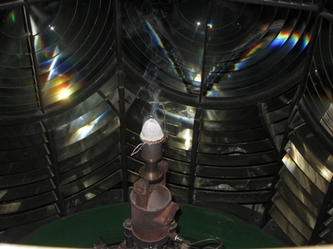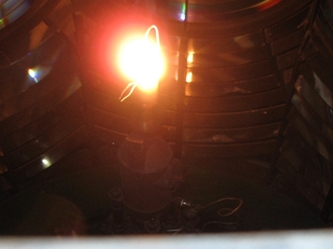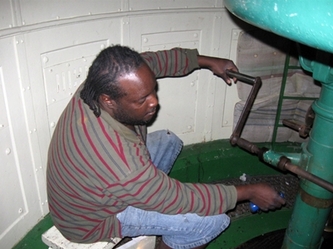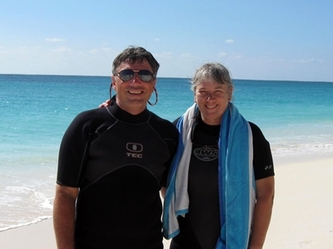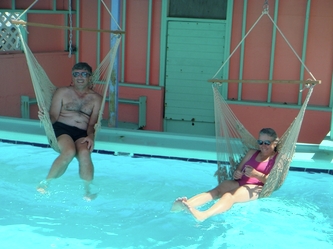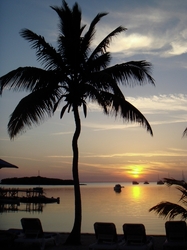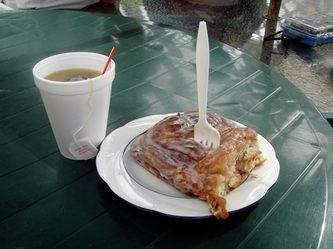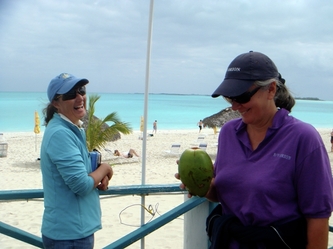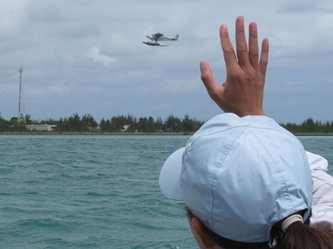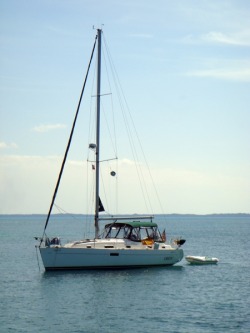
Orion anchored off Treasure Cay
We spent the last 2 weeks of March near the “hub” of the Abacos, in the islands immediately surrounding Marsh Harbor, before heading back to the states in another long run to Charleston.
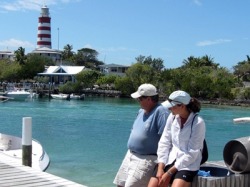
The Elbow Cay Reef Light rises up behind Fred and Julie in Hopetown harbor.
Let There Be Light
We returned to Hopetown, with its signature candy-striped lighthouse, for a couple of days during this visit to the Abacos. We managed to snorkel the reef again, sample some conch fritters at Munchies and take away 2 freshly-baked loaves of whole wheat bread (they were literally fresh out of the oven) from Vernon’s. However, the highlight of the trip was a return trip to the top of the lighthouse – this time at sunset. This is one of the few lighthouses in the world still manually lit and wound using its original works. It was a rare treat to be allowed to see how it is done.
We returned to Hopetown, with its signature candy-striped lighthouse, for a couple of days during this visit to the Abacos. We managed to snorkel the reef again, sample some conch fritters at Munchies and take away 2 freshly-baked loaves of whole wheat bread (they were literally fresh out of the oven) from Vernon’s. However, the highlight of the trip was a return trip to the top of the lighthouse – this time at sunset. This is one of the few lighthouses in the world still manually lit and wound using its original works. It was a rare treat to be allowed to see how it is done.
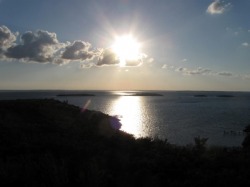
Sea of Abaco from the Elbow Cay Reef Light at sunset
About a half-hour before sunset, we dinghied over to the light, climbed the 101 steps to the top, and took in the spectacular view as the sun slowly descended over the Sea of Abaco. However, as the sun sank lower, we found ourselves alone at the top, expecting the lighthouse keeper to appear any minute to begin the lighting process. But the sun dipped below the horizon and there was no one even approaching the lighthouse entry below. Also, the interior of the lighthouse was getting pretty dark with the dwindling light, which made us a little worried about descending safely. So, we headed down and began to hover around the entrance, looking for someone coming to light the light in the gathering dusk.
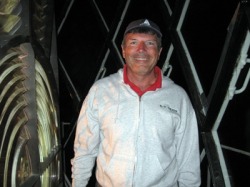
We were allowed to climb up on a level with the Fresnel lens.
Finally, Dave saw someone at one of the cottages at the base of the light, who said he was indeed the lightkeeper and would be willing to let us watch him light the light, although usually this wasn’t allowed. We climbed back up to the top and Jeffrey followed turning on the interior lights to make the return trip easier. Jeffrey is a 2nd generation lightkeeper, following in his father’s footsteps, who retired 5 years ago after 35 years in the job. He was generous in allowing us to view his handiwork, even letting us climb up to the platform on a level with the Fresnel lens to get a better view.
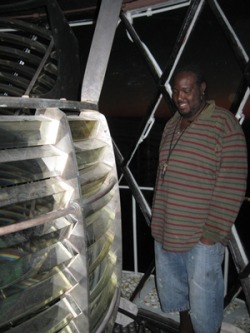
Jeffrey is one of 2 lightkeepers
But we didn’t delay him in his work. He climbed inside the lens (using the opening that is the light’s “off” sequence), to begin the process. In order to get the kerosene burner heated to allow it to light, Jeffrey started by pouring alcohol into a small pan that fitted into the column that held the light’s mantle and lit this. Then, he had to wait for 15 to 20 minutes while it heated the burner. While he waited, he took down the curtains that shield the lens from the sun, preventing any accidental fires created by the lens’ magnifying effect on the sun during the day. Soon, smoke started rising from the mantle, indicating the burner had reached the right temperature to be lit. It didn’t take long after lighting before it was glowing bright, but it was still amazing at how such a small light could become such a dramatic beacon. Next he had to release the brake that would allow the lens to spin, creating the beacon’s signature frequency. Finally, he raised the weight that drove the lens’ rotation by operating a crank beneath the light. This would allow it to turn for 2 hours, when he would be back to do it again.
Jeffrey shares the lightkeeper’s job with another man, who has been doing it for 37 years, each taking the job of cranking the weight every 2 hours for half the night. Our thanks to him for this fascinating view into the lightkeeper’s special world.
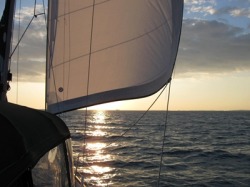
Orion sails into the sunrise across the Sea of Abaco.
Great Guana - Treasure Cay - Marsh Harbor
We kept bouncing back and forth between the anchorages across the Sea of Abaco, staying near Great Abaco when the winds blew from the west and moving to the out islands when they settled and blew from the east. At Great Guana, we snorkeled, walked the beach, enjoyed the pool and the view at Nippers, and socialized at the Wednesday potluck at Grabbers. While at Treasure Cay on Great Abaco, we sampled the famous Café La Florence cinnamon bun and took in their award-winning beach, and then back in Marsh Harbor, we made preparations for our return trip to states – studying the weather, planning routes, changing the oil, topping off propane and food, and repositioning the cabin for a longer time underway.
We kept bouncing back and forth between the anchorages across the Sea of Abaco, staying near Great Abaco when the winds blew from the west and moving to the out islands when they settled and blew from the east. At Great Guana, we snorkeled, walked the beach, enjoyed the pool and the view at Nippers, and socialized at the Wednesday potluck at Grabbers. While at Treasure Cay on Great Abaco, we sampled the famous Café La Florence cinnamon bun and took in their award-winning beach, and then back in Marsh Harbor, we made preparations for our return trip to states – studying the weather, planning routes, changing the oil, topping off propane and food, and repositioning the cabin for a longer time underway.

Dave hoists the quarantine flag
Back to the US
As the first of April approached, we knew Marianna would be heading back to the US with the first weather window. We began looking at the weather as well, but were going to follow only if it allowed for a run all the way to Charleston. Traveling through Florida had no appeal at this point. Amazingly, a perfect weather window began to be forecast for – what else? – April 1st. As it began to be more certain that this was for real, we made our plans to take advantage of it. We sat in Marsh Harbor for the winter’s last angry blow, which actually spawned a tornado in Freeport, but as soon as the winds began to settle down, we looked for our opportunity to move.
As the first of April approached, we knew Marianna would be heading back to the US with the first weather window. We began looking at the weather as well, but were going to follow only if it allowed for a run all the way to Charleston. Traveling through Florida had no appeal at this point. Amazingly, a perfect weather window began to be forecast for – what else? – April 1st. As it began to be more certain that this was for real, we made our plans to take advantage of it. We sat in Marsh Harbor for the winter’s last angry blow, which actually spawned a tornado in Freeport, but as soon as the winds began to settle down, we looked for our opportunity to move.
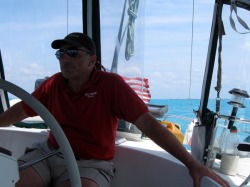
Heading north for Manjack
As with so much of our travel this winter, sailing wasn’t an option. We pulled out of our slip early on Wednesday, March 30th, timing our departure more for the high tide, rather than the diminished winds. The Sea of Abaco was rough and our northerly course took us almost directly into the seas and winds which were still gusting to 25knots. We managed to get enough of a report about the Whale to believe it would be safe to transit, which was true, but it was the roughest we have experienced with waves up to 6 feet and wind chop making the seas confused. By the time we set anchor in Manjack, Orion was covered with salt, but the price of a rougher day for this trip was small to pay for the long smooth ride in the Gulf Stream promised by Chris Parker in the forecast for the next few days.
With little opportunity to sail, we wanted to position ourselves to be able to top off Orion’s fuel tanks as late as possible before leaving the Little Bahama Bank. We also wanted to arrive in Charleston earlier in the day on Saturday, since the current would turn against us around noon. (Last year we arrived at 2:30pm.) That meant shaving 5 hours or so off our running time from last year. To do this, we decided to anchor on the banks, about 15 miles beyond Great Sale Cay, our starting point for last year’s trip. We traveled from Manjack at first light, heading out at the lead of a dozen or more boats taking advantage of the same weather. Every hour or so to break up the monotony of the long day, Cathy would run a Jeopardy quiz show on the radio, using a calendar she got for Christmas. This was something we had done all winter with Marianna. However, with the first round, we were joined by Aurora, who chimed in on an answer that had Marianna’s crew stumped. With each passing round, the participants grew, until we had 5 boats playing: River Rat, Grateful Attitudes, Aurora, Marianna and Our Turn. We cruisers are easily amused.
With little opportunity to sail, we wanted to position ourselves to be able to top off Orion’s fuel tanks as late as possible before leaving the Little Bahama Bank. We also wanted to arrive in Charleston earlier in the day on Saturday, since the current would turn against us around noon. (Last year we arrived at 2:30pm.) That meant shaving 5 hours or so off our running time from last year. To do this, we decided to anchor on the banks, about 15 miles beyond Great Sale Cay, our starting point for last year’s trip. We traveled from Manjack at first light, heading out at the lead of a dozen or more boats taking advantage of the same weather. Every hour or so to break up the monotony of the long day, Cathy would run a Jeopardy quiz show on the radio, using a calendar she got for Christmas. This was something we had done all winter with Marianna. However, with the first round, we were joined by Aurora, who chimed in on an answer that had Marianna’s crew stumped. With each passing round, the participants grew, until we had 5 boats playing: River Rat, Grateful Attitudes, Aurora, Marianna and Our Turn. We cruisers are easily amused.
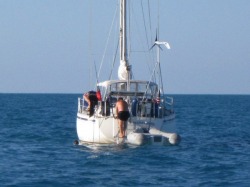
Marianna’s crew takes a final swim in the Bahamas for this trip.
Around 5:30pm, we pulled off the route line and anchored south of a giant sand bar, Lily Sand Bank, although from the endless water around us in every direction, you’d never know it. As Orion’s crew scurried to re-fuel and prepare supper before sunset, Marianna’s crew took a final swim in the blue waters of the Bahamas. Boy, maybe it’s time to jump ship.
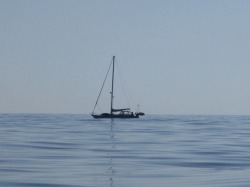
Marianna glides along on an ocean that is like glass.
We were up early the next day, leaving at 5am, an hour before Marianna. With Orion’s tighter fuel situation, we need to pace ourselves in case we couldn’t re-fuel as much as we planned due to rougher conditions. However, we needn't have worried. The roughest conditions occurred in the late afternoon that day, with 3-4ft seas. But, as forecast, these moderated to flat calm conditions, which persisted the rest of the trip. The only drama came in the form of boat traffic in and out of Savannah. For example, it took a while for a departing cargo ship to acknowledge that he would not clear both of us if he stayed on his present course. At the last minute, he turned to pass astern.
Not everything was going so well on Orion, though. Before leaving the Bahama banks, Cathy went to turn on the inverter to charge the laptop, when a nasty spark and some accompanying smoke prompted Dave to disconnect it until further investigation could be done. Then, at the end of the first day, the toilet stopped working. You don’t want to know what we had to do about that one. The next morning, the ham radio wouldn’t power up. That turned out to be just a fuse, but it took a bit of work to discover it. And then, as if to remind us that it's still there, the rudder started leaking just 4 hours out of Charleston in a sea so smooth it could be mistaken for glass. Go figure.
Not everything was going so well on Orion, though. Before leaving the Bahama banks, Cathy went to turn on the inverter to charge the laptop, when a nasty spark and some accompanying smoke prompted Dave to disconnect it until further investigation could be done. Then, at the end of the first day, the toilet stopped working. You don’t want to know what we had to do about that one. The next morning, the ham radio wouldn’t power up. That turned out to be just a fuse, but it took a bit of work to discover it. And then, as if to remind us that it's still there, the rudder started leaking just 4 hours out of Charleston in a sea so smooth it could be mistaken for glass. Go figure.
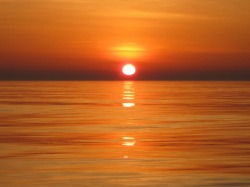
Despite our troubles, we made it into Charleston on schedule after 51 hours at sea, entering the inlet around 8am and pulling into our slip by 9:30am, just ahead of Marianna, right on schedule. Customs was even there to meet us and clear us in just after we arrived. It was almost too easy.
And now we are set to enjoy another Easter in Charleston. It doesn’t get any better than this! (Well, except for a working toilet . . .)
And now we are set to enjoy another Easter in Charleston. It doesn’t get any better than this! (Well, except for a working toilet . . .)
